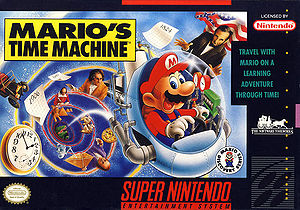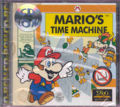Mario's Time Machine
Mario's Time Machine is an edutainment title that was released for the SNES and PC in December 1993; it was later released on the NES on April 23, 1994[1]. It is usually meant to teach younger players basic world history and is the last game before discontinuation. It is worthy to note that this is the only game in the Mario series in which Mario as a protagonist has full lines of dialogue.
Story
In the year 1993 (or 2000 in the , Bowser builds a time machine called the Timulator, which he uses to travel backwards to different points in human history and steals significant artifacts to place in his personal museum. Mario must take back the artifacts and return them to their proper places in time before history becomes irreversibly damaged.
In the NES version of the game, Yoshi joins Mario in his quest to stop Bowser's plot, but instead gets captured. In addition to fixing the timeline Mario must also rescue Yoshi from peril.
Gameplay
SNES
The central hub of Mario's Time Machine is the museum within Bowser's castle. The museum is three floors high, and on each floor lies five artifacts, giving Mario a total of fifteen periods of time to travel to. Mario must take an artifact from a pedestal, look at the date and location labeled on it, and then program that information into the Timulator and travel to that point in the timeline.
When the player arrives in the time period, he must explore and converse with the various residents that live there. In doing so, the player learns about the artifact, the time period, and the person associated with it. To get more information, the player must receive items that some residents possess and give them to others in order to satisfy their needs. For example, in Vienna one resident will complain about the heat until Mario retrieves a fan and hands it to the person, who will then continue to give information. After the player has talked to everyone, the player fills out a History answer sheet. The answer sheet consists of a two-page biography about the person associated with the artifact and the time period, with blanks replacing several words. The player must use the information he received to correctly fill in the blanks. If the player fills in the wrong answer more than twice, the player is forced back into the present. If he succeeds, Mario can return the artifact to its owner and return back to 1993.
After all the artifacts of a floor have been returned, Mario moves upward to the next floor.
A timer and a hidden Checklist are used throughout the game. How long the player spends in each time period and the order in which he returns each artifact will total up to one of three different endings. If the player spends too much time returning all the artifacts or returns even ONE artifact in the wrong order, Bowser escapes to "Paradise" using the Timulator; then the player must start over from the beginning, or use a password to go back to a previous point. However, if they meet the two objective conditions, the Timulator overloads, self-destructs and sends Bowser to the Jurassic period where he gets stepped-on by a Tyrannosaurus Rex.
Time Periods
The time periods that Mario visits in each version varies. Here is a chart of the location and artifact for the NES and SNES versions in chronological order.
NES
- 80M BC — (Egg)
- 776 BC — (Torch)
- 31 BC — (Throne)
- 1192 — (Sword)
- 1520 — (Steering Wheel)
- 1602 — (Pen)
- 1687 — (Apple)
- 1862 — (Stovepipe Hat)
- 1879 — (Light bulb)
- 1903 — (Propeller)
- 1905 — (Physics Equation)
- 1947 — (Flag)
- 1969 — (Flag [United States])
- 1989 — (Sledgehammer)
SNES
- 369 BC — Athens (The Republic book)
- 49 BC — Alexandria (Royal Staff)
- 1292 — Gobi Desert (Printing Block)
- 1429 — Orleans (Shield)
- 1455 — Mainz (Printing Machine)
- 1503 — Florence (Chisel)
- 1505 — Florence (Papers)
- 1521 — Pacific Ocean (Globe)
- 1595 — England (Queen Elizabeth the First's Crown)
- 1601 — Stratford upon Avon (Skull)
- 1776 — Philadelphia (Declaration of Independence)
- 1824 — Vienna (Music Sheet)
- 1847 — Cambridge (Apple)
- 1879 — Menlo Park (Filament)
Gallery
- TimeMachineScreen.png
The title screen of the NES version
- TitleScreenMachine65.jpg
The title screen for the SNES version.
- Bowsertimemachine.PNG
Bowser and his minions with the Timulator.
- TimeMachinePhiladelphia65.jpg
Mario returns the Declaration of Independence.
- TimeMachineImage65.jpg
Mario in Orleans.
- BowserTimeMachine65.jpg
Bowser appears.
- EndingMachine65.jpg
The end of the game.



